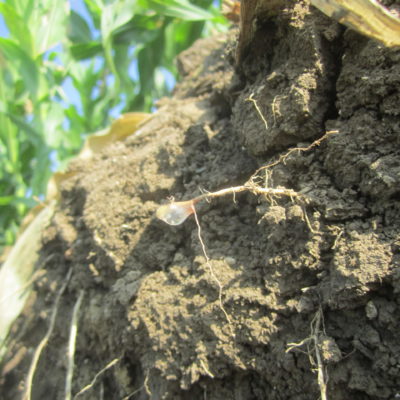I have received many phone calls asking about the optimal time to chop corn silage based on moisture. Unfortunately, this late in the chopping season, most corn crops are too dry to meet the guideline of between 33-38% dry matter as covered at the Silage for Beef Cattle 2018 Conference. A lot of the green chop sample that have been analyzed here at Ward Laboratories, Inc. in the past week have been closer to 50% dry matter!
There are several reasons it is recommended to chop corn silage at a lower dry matter and higher moisture content. First, nutritionally an immature plant will have a higher moisture content, and lower fiber content and higher relative feed value and available energy to the animal. Conversely, as plant maturity increases and moisture content decreases, acid detergent fiber and neutral detergent fiber increase resulting in lowered relative feed value and less available energy to the animal. The longer the crop stands in the field and dry, the less palatable it becomes, and animals consume less. In addition to consuming less of the silage, drier corn plants mean harder corn grains making the starch less available to the animal for energy. So, the animal is consuming an insufficient amount of a low energy feed due to gut fill and digestibility constraints. Second, when silage is chopped dry it doesn’t pack densely and leaves room for oxygen. The aerobic environment invites unwanted molds and toxins into the silage pile. Here are several options to correct for moisture when packing dry corn silage:
- Add moisture back. The most obvious answer is to add water to the silage pile. This might be trickier and less feasible than it seems. The recommendation is to add four gallons of water per ton of silage for every 1 percent raise in moisture content desired. It is important to add the water as you pack the silage because if it does not properly infiltrate the chopped silage it will result in seepage and loss of nutrients and will not result in the desired anaerobic environment to prevent mold and spoilage. Some amount of moisture can also be added back in the form of liquid inoculants.
- Use a finer chopping length. Chopping the whole corn plants into smaller pieces in combination with through packing procedures can allow for denser packing. Smaller pieces pack tighter together and allow for less oxygen infiltration and thereby less mold and mycotoxin issues.
- Mix in other wetter forages. By mixing in other wetter forages such as freshly chopped alfalfa or sudan, the overall weight and moisture of the silage pile will increase making packing more efficient and again reducing the presence of oxygen and mold.
- Consider other options such as snaplage, earlage, or high moisture corn. Snaplage can be ensiled when the whole plant dry matter is between 60-65 % and kernel dry matter is between 66-72%. High moisture corn can be ensiled with the kernel is between 70-74% dry matter.
As with any silage, it is important to always pack thoroughly, cover with anaerobic plastic and allow to ensile for 90 to 120 days. Once the ensiling process is complete consider sending a sample to Ward Laboratories, Inc. to test for nutritional values, mold count, pH, and aflatoxin.




